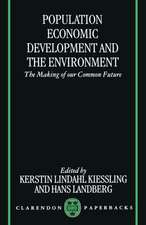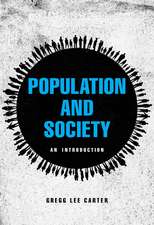The History of Human Populations: Volume I, Forms of Growth and Decline
Autor P. M. G. Harrisen Limba Engleză Hardback – 29 iul 2001 – vârsta până la 17 ani
| Toate formatele și edițiile | Preț | Express |
|---|---|---|
| Hardback (2) | 468.53 lei 6-8 săpt. | |
| Bloomsbury Publishing – 29 iul 2001 | 468.53 lei 6-8 săpt. | |
| Bloomsbury Publishing – 29 aug 2003 | 471.40 lei 6-8 săpt. |
Preț: 468.53 lei
Preț vechi: 641.83 lei
-27% Nou
Puncte Express: 703
Preț estimativ în valută:
89.66€ • 95.87$ • 74.75£
89.66€ • 95.87$ • 74.75£
Carte tipărită la comandă
Livrare economică 17 aprilie-01 mai
Preluare comenzi: 021 569.72.76
Specificații
ISBN-13: 9780275971311
ISBN-10: 0275971317
Pagini: 464
Dimensiuni: 156 x 235 x 38 mm
Greutate: 0.87 kg
Ediția:00013
Editura: Bloomsbury Publishing
Colecția Praeger
Locul publicării:New York, United States
ISBN-10: 0275971317
Pagini: 464
Dimensiuni: 156 x 235 x 38 mm
Greutate: 0.87 kg
Ediția:00013
Editura: Bloomsbury Publishing
Colecția Praeger
Locul publicării:New York, United States
Notă biografică
P.M.G. HARRIS is Professor Emeritus of History at Temple University.
Cuprins
IntroductionsPrefaceIntroductionNew Viewpoints on an Old Topic: What Form Does Population Growth Take--and Why?Patterning the Parts as Well as the Whole across Four Centuries of American Demographic IncreaseCommon Forms of Growth for All New Settlements? Evidence from Other Northern European ColonizationsOther Striking But General G-Based Trends: "Demographic Disaster" and "Population Explosion" in Latin America, the Caribbean, and OceaniaThe Growth and Decline of Old World Peoples: Insights from Europe, Where the Debate BeganHow Regional Changes of Population in Europe Underlay National Ones--from Andalusia to the Amur, from Trondheim to the TiszaSketching Population History in Asia and Africa: Outlines of the Often ObscureThe Growth of Cities and the Spread of UrbanizationThe Local Generality of the Simplest G-Shaped Trends: Cross-Cultural Examples Over TimeConclusionAppendixBibliographyIndex





















